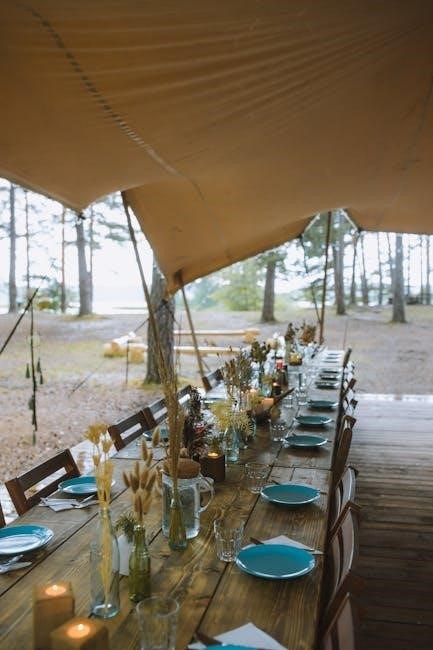canopy tent instructions
Canopy tents are portable shelters offering shade and protection. Ideal for outdoor events, they provide durable, versatile, and easy-to-assemble solutions. Perfect for various settings, ensuring comfort and style.
1.1 What is a Canopy Tent?
A canopy tent is a portable shelter designed to provide shade and protection. It typically features a collapsible frame, usually made of aluminum or steel, and a durable fabric canopy. These tents are lightweight, easy to assemble, and often used for outdoor events, picnics, or temporary shade solutions. They come with stakes, ropes, and sometimes sandbags for securing the structure. Canopy tents are versatile, offering a practical and stylish way to create covered spaces in various settings.
1.2 Benefits of Using a Canopy Tent
Canopy tents offer numerous benefits, including portability, ease of setup, and durability. They provide excellent shade and protection from elements, making them ideal for outdoor events. Versatile designs cater to various needs, from casual gatherings to professional setups. Pop-up and instant canopies are particularly popular for their quick assembly. Durable materials ensure longevity, while lightweight frames make them easy to transport. Canopy tents are a practical and stylish solution for creating shaded spaces.
1.3 Popular Uses of Canopy Tents
Canopy tents are widely used for outdoor events like weddings, festivals, and markets. They provide shade and shelter for backyard gatherings, picnics, and beach trips. Commercially, they are ideal for promotional events, trade shows, and product displays. Sports events and camping trips also benefit from their portability and durability. Versatile and practical, canopy tents are a reliable choice for various outdoor activities, ensuring comfort and protection in diverse settings.
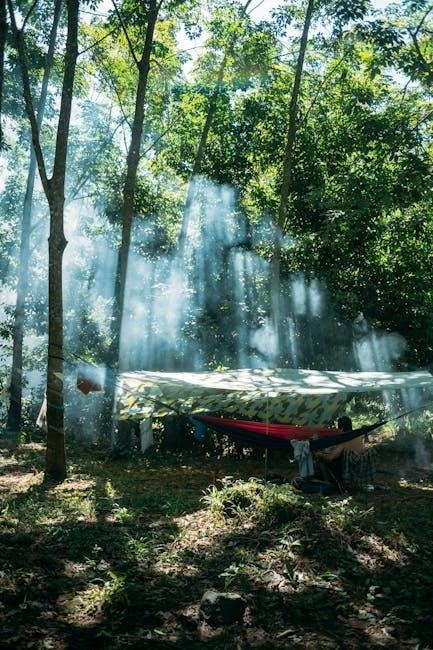
Preparing for Setup
Before setting up, choose a flat, stable site and clear debris. Gather essential tools like stakes, ropes, and Allen wrenches. Ensure all parts are included for a smooth process.
2.1 Choosing the Right Location
Selecting a flat, stable site is crucial for safe setup. Ensure the area is free from sharp objects and obstructions. Opt for a spot with good drainage to avoid water pooling. Consider wind direction to enhance stability and prevent damage. Clear the site thoroughly before unpacking to ensure a smooth and secure setup process. Always prioritize a level surface for optimal performance and safety.
2.2 Clearing the Site
Before setting up, thoroughly clear the area of debris, rocks, and vegetation. Remove sharp objects to prevent tent damage. Ensure the ground is even and free from obstructions. This step ensures a stable base and prevents potential punctures or uneven positioning. A clean site also facilitates easier stake insertion and rope anchoring, crucial for securing the canopy effectively and safely. Proper clearance is essential for a successful setup.
2.3 Essential Tools and Hardware
Ensure you have steel stakes, durable ropes, and sandbags or weights for securing the canopy. A rubber mallet and measuring tape are useful for precise setup. Include a wrench or Allen key for frame adjustments and a ladder for taller canopies. These tools ensure stability and proper assembly, making the setup process efficient and secure. Having all hardware ready prevents delays and ensures a sturdy structure.

Unpacking and Organizing
Unpack the canopy tent carefully, identifying all hardware and components. Organize parts by category to ensure easy access during setup, saving time and reducing confusion.
3.1 Unloading the Canopy Tent
When unloading the canopy tent, carefully remove each component from the packaging. Inspect for damage and ensure all parts are included. Start by lifting the frame and placing it on a flat surface. Next, remove the canopy top, stakes, ropes, and hardware. Organize these items in a designated area to streamline the setup process.
3.2 Identifying Hardware and Parts
Begin by identifying the hardware and parts included with your canopy tent. Locate the frame poles, connectors, stakes, ropes, and canopy top. Check for any specific labels or color coding that may indicate their purpose. Familiarize yourself with each component to ensure a smooth assembly process. Refer to the instruction manual if you need help distinguishing any parts. Proper identification is key to efficient setup.
3.3 Sorting Components for Easy Access
Organize all hardware and parts into categories for easy access during setup. Separate poles, connectors, stakes, and ropes into labeled groups. Place smaller items like screws and clips in sealed bags to prevent loss. Arrange components in the order they will be used, ensuring everything is within reach. This systematic approach saves time and reduces the risk of missing or misplaced parts during assembly.
Step-by-Step Setup Instructions
Expand the frame, attach the canopy, and secure it with stakes and ropes. Follow detailed steps to ensure a safe and stable setup, protecting against wind and weather.
4.1 Expanding the Frame
Begin by expanding the tent frame, ensuring it is on a flat surface. Locate the spindle under the canopy and pull the lever to extend the upper peak pole. Gently lift and expand the frame, ensuring all joints click securely into place. Check for stability and alignment before proceeding. Make sure the frame is fully open and evenly balanced to provide a sturdy base for the canopy.
4.2 Attaching the Canopy Top
Drape the canopy top evenly over the expanded frame, aligning the corners with the frame’s poles. Secure each corner by attaching the Velcro straps or clips to the frame. Tighten the straps gradually to ensure a snug fit. Adjust the canopy for even tension, ensuring no sagging or wrinkles. Double-check all connections to confirm the canopy is firmly attached and properly aligned for optimal stability and appearance.
4.3 Securing the Frame and Canopy
Use steel stakes to anchor the frame’s legs into the ground, ensuring each corner is tightly secured. Apply sandbags or weights for added stability, especially on hard surfaces. Tighten all bolts and screws to prevent shifting. For windy conditions, employ extra ropes to tie the canopy to nearby stable structures. Ensure all parts are snug and balanced for maximum durability and safety during use.
4.4 Final Adjustments and Tightening
Once the frame and canopy are secured, perform a final inspection to ensure all parts are properly aligned. Tighten any loose bolts or screws, and verify the canopy top is evenly spread and taut. Adjust the legs to maintain balance and evenness, especially on uneven surfaces. Ensure all ropes and stakes are firmly in place for maximum stability. Double-check all connections for tightness and durability.
Securing the Canopy Tent
Use stakes, ropes, and sandbags or weights to ensure stability. Check all connections and tighten as needed for a firm, wind-resistant setup. Ensure safety and durability.
5.1 Using Stakes and Ropes
Drive stakes into the ground at a 45-degree angle, securing each corner of the canopy; Tighten ropes firmly to ensure stability, especially in windy conditions. Use high-quality stakes and ropes to prevent shifting, and double-check all knots for security. This method ensures your canopy remains stable and safe during events or outdoor activities.

5.2 Applying Sandbags or Weights
Sandbags or weights are essential for securing canopy tents on surfaces like concrete or grass. Fill sandbags with sand or rocks and attach them to the canopy’s legs using the provided cords. Ensure the bags are tightly cinched and evenly distributed for maximum stability. For added grip, pull the bags apart as far as possible. This method is ideal for windy conditions and ensures the tent remains firmly in place during events.
5.3 Ensuring Stability in Windy Conditions
Ensuring your canopy tent’s stability in windy conditions is crucial for safety and durability. Use steel stakes to secure the tent firmly to the ground, and consider adding sandbags for extra weight. Expand the frame fully, attach the canopy top tightly, and ensure all connections are secure. Regularly check and tighten all parts to maintain stability and prevent damage from strong winds, especially during events.
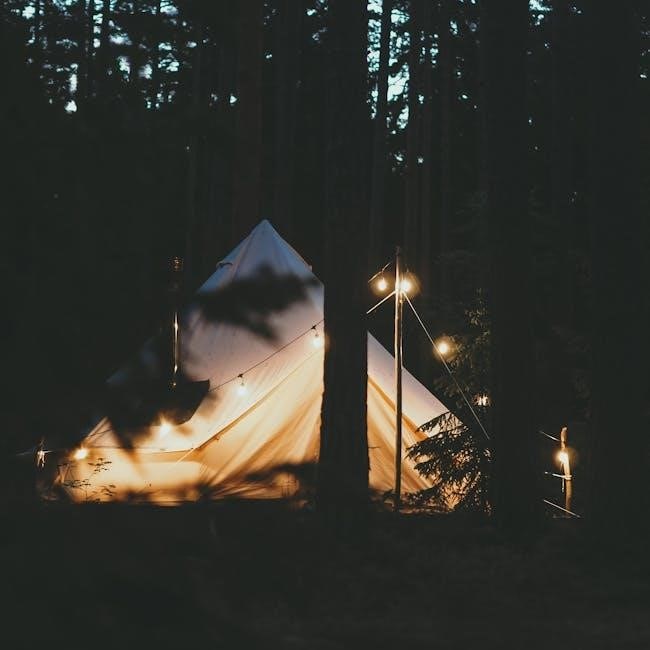
Customizing Your Canopy Tent
Customize your canopy tent with banners, lighting, or decorations to enhance its appearance and functionality. Add branding, incorporate LED lights, or improve ventilation for a personalized touch.
6.1 Adding Banners or Branding
Add banners or branding to your canopy tent for a personalized touch. Use Velcro, hooks, or straps to securely attach banners to the canopy’s edges or valance. Ensure the design aligns with the tent’s structure for a professional appearance. Many manufacturers provide specific instructions for attaching banners, making it easy to promote your brand or event seamlessly.
6.2 Incorporating Lighting or Decorations
Incorporate lighting or decorations to enhance your canopy tent’s ambiance. Use string lights, lanterns, or fairy lights to create a warm atmosphere. Decorations like banners, flowers, or themed items can add visual appeal. Ensure lights are securely attached and use battery-operated options for safety. Decorations should be lightweight and properly fastened to avoid damage or instability, ensuring a stylish and functional setup for any event or gathering.
6.3 Enhancing Ventilation and Shade
Enhance ventilation and shade by using mesh panels or breathable fabrics. Position the tent to maximize natural airflow and shade. Consider adding side panels or awnings for extra shade. Use accessories like roof vents or cooling units for better air circulation. Ensure all additions are securely attached to maintain stability and provide a comfortable environment for users, especially in warm or sunny conditions.
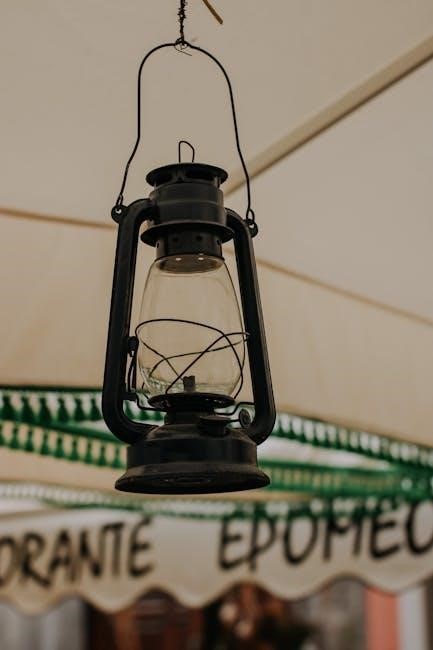
Maintenance and Storage
Enhance ventilation by incorporating mesh panels or breathable fabrics. Use side panels or awnings for additional shade. Install roof vents or cooling units to improve airflow. Ensure all modifications are securely attached to maintain stability and provide a comfortable environment, especially in warm or sunny conditions.
7.1 Cleaning the Canopy Tent
Clean the canopy tent regularly to maintain its durability. Use mild soap and water to wipe down fabric and frames. Avoid harsh chemicals or abrasive cleaners. Brush off dirt before washing to prevent damage. Allow the tent to dry completely after cleaning to prevent mildew. For tough stains, gently scrub with a soft brush. Never machine wash or bleach the fabric. Always follow manufacturer-specific cleaning instructions for optimal results.
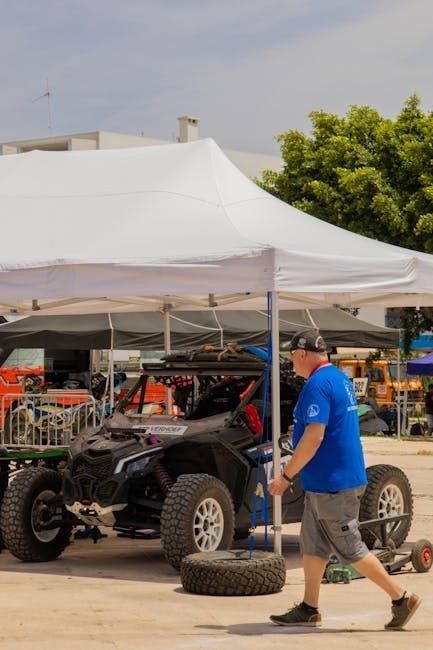
7.2 Dismantling and Packing
Dismantle the canopy tent by detaching the canopy top from the frame. Carefully fold the fabric to avoid creases or tears. Remove all hardware and store separately in labeled bags. Collapse the frame and secure it with straps. Place all components, including stakes and ropes, into the storage bag. Ensure the tent is completely dry before packing to prevent mildew. Follow the manufacturer’s instructions for proper packing to maintain the tent’s condition and longevity.
7.3 Storing the Tent Properly
Store the canopy tent in a clean, dry, and well-ventilated area to prevent mildew. Use the provided storage bag or a sturdy container to keep components organized. Hardware and small parts should be stored separately in labeled bags. Avoid leaving the tent assembled, as this can cause damage. Ensure all fabric is completely dry before storage to prevent mold growth. Keep the tent in a cool, dry place, away from direct sunlight and moisture.

Troubleshooting Common Issues
Address damaged parts with repair kits, fix leaks using sealants, and ensure frame stability by tightening connections. Check for loose components and secure anchoring to prevent issues.
8.1 Dealing with Damaged or Missing Parts
If parts are damaged or missing, inspect the tent thoroughly. Use repair kits for minor tears or dents. Contact the manufacturer for replacements. Check for backup supplies in the packaging. If unavailable, source compatible parts from hardware stores. Ensure all components are securely tightened to maintain structural integrity. Refer to the instruction manual for specific guidance on replacing or repairing damaged elements.
8.2 Fixing Leaks or Tears
To fix leaks or tears, start by identifying the damaged area. Apply a waterproof sealant or fabric repair tape directly to the affected spot. For larger tears, use a fabric patch kit, ensuring the patch is securely attached with adhesive or stitches. Allow the repair to dry completely before testing. Regular inspections and timely repairs can prevent further damage and extend the tent’s lifespan.
8.3 Addressing Frame Stability Problems
If the frame is unstable, check all connections and tighten any loose bolts or screws. Ensure the tent is secured with stakes and weights, especially in windy conditions. Straighten bent poles and replace damaged parts if necessary. Regularly inspect the frame for wear and tear to maintain stability. Proper assembly and securing techniques are key to preventing frame issues during use.
Safety Tips and Precautions
Ensure stability with stakes and ropes. Avoid overloading. Monitor weather. Secure assembly. Professional help recommended for large tents.
9.1 Avoiding Overloading the Canopy
Avoid overloading the canopy to prevent structural damage or collapse. Use steel stakes and sandbags for stability, especially in windy conditions. Distribute weight evenly and avoid excessive decorations. Follow manufacturer guidelines for weight limits and ensure the tent is securely anchored. Regularly inspect for wear and tear to maintain safety and durability. Proper securing ensures a stable and safe canopy tent setup.
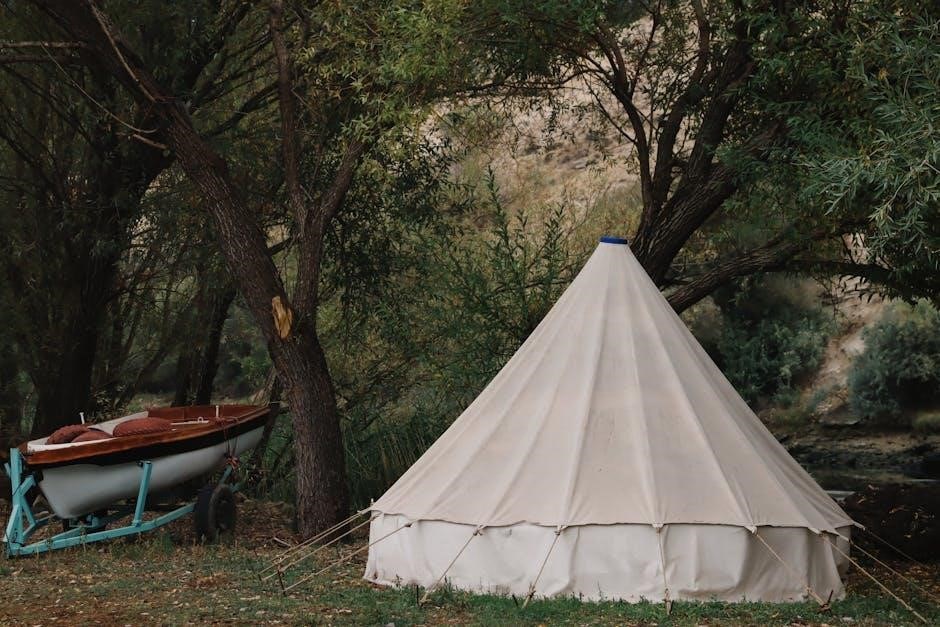
9.2 Monitoring Weather Conditions
Always monitor weather conditions before and during canopy tent use. Avoid setting up in heavy rain, strong winds, or extreme heat. Ensure the tent is securely anchored with stakes and weights to withstand gusts. Check forecasts beforehand and have a backup plan for severe weather. Regularly inspect the tent for damage during prolonged use. Stability and safety are crucial in varying conditions.
9.3 Ensuring Safe Assembly and Disassembly
Always follow the manufacturer’s instructions for safe assembly and disassembly. Wear protective gloves and ensure all parts are securely locked. Avoid over-tightening components to prevent damage. Use proper tools and maintain balance to prevent the tent from collapsing. Never assemble or disassemble during strong winds. Ensure all parts are accounted for and stored safely after use to prevent accidents and extend the tent’s lifespan.
Additional Resources
Explore instructional videos, manufacturer FAQs, and community forums for guidance. These resources offer detailed setup tips, troubleshooting, and customization ideas to enhance your canopy tent experience.
10.1 Instructional Videos and Guides
Instructional videos and guides provide step-by-step instructions for setting up and customizing canopy tents. Videos from manufacturers like ImpactCanopy offer detailed tutorials, while written guides cover topics like frame assembly and canopy attachment. These resources often include tips for troubleshooting common issues and ensuring a secure setup. They are essential for beginners and experienced users alike, helping to enhance setup efficiency and safety.
Manufacturers provide comprehensive support, including FAQs, to address common questions about canopy tent setup and maintenance. Many companies, like ABCCanopy, offer detailed manuals and customer service. FAQs cover topics such as frame assembly, securing stakes, and troubleshooting. This support ensures users can resolve issues quickly, making the setup process smoother and more efficient for all skill levels. Community forums and reviews are invaluable for sharing experiences and tips on canopy tent setup. Users often discuss their favorite models, setup hacks, and troubleshooting advice. Reviews highlight pros and cons, helping others make informed decisions. Many forums feature step-by-step guides and photos from experienced users, offering practical insights. These platforms foster a sense of community, empowering newcomers with real-world advice and solutions. They are a key resource for mastering canopy tent assembly and care. Setting up a canopy tent is a straightforward process with the right tools and preparation. By following the instructions and tips outlined, you can ensure a safe and enjoyable experience. Happy camping! Ensure a flat, stable site and use high-quality stakes or weights for stability. Double-check frame alignment and secure all connections tightly. Regularly inspect the tent for wear and tear. Practice setup beforehand for efficiency. Always follow the manufacturer’s instructions and safety guidelines. Keep tools and spare parts handy for quick adjustments. Proper preparation and attention to detail will ensure a safe and successful canopy tent experience every time. A well-set-up canopy tent enhances outdoor gatherings, providing shade and comfort. Personalize your space with decorations or lighting for a unique atmosphere; Whether hosting events, relaxing, or enjoying nature, it offers versatility and style. Share memorable moments with family and friends under its shelter. Embrace the freedom to create lasting experiences wherever you go, making every occasion special and enjoyable with your canopy tent.10.2 Manufacturer Support and FAQs
10.3 Community Forums and Reviews
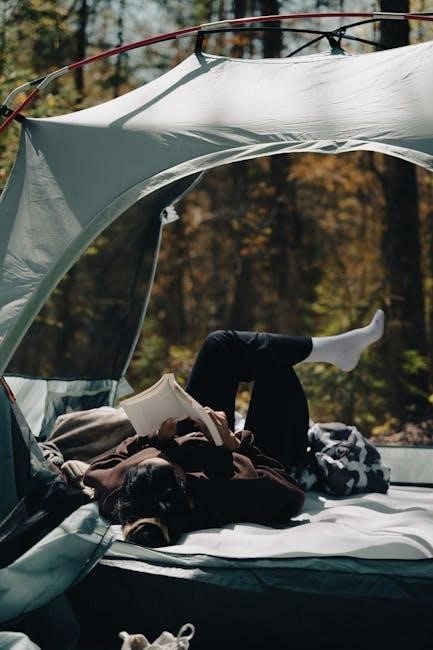
11.1 Final Tips for a Successful Setup
11.2 Enjoying Your Canopy Tent Experience

